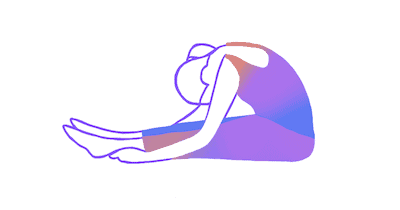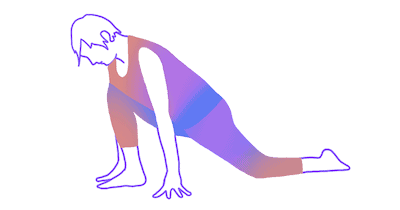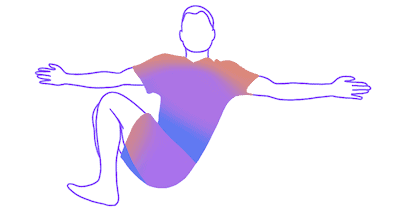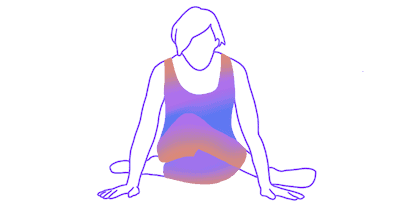
Yoga can be an incredibly powerful, therapeutic, and healing force, especially when guided by a knowledgeable and ethical yoga therapist. It has even been shown to help trauma survivors, reshaping their responses to triggers and reducing their symptoms, stress, and anxiety. But there are several important considerations to take into account in order to provide a safe, healing experience for survivors, especially if you’re considering Yin Yoga for trauma.
I’m Brandt Passalacqua, the Founder, Director, and Lead Teacher at Breathing Deeply Yoga Therapy, where I train students to become certified yoga therapists. I’ve had the privilege of working with thousands of clients and have seen firsthand how yoga therapy can help those who have suffered trauma. Below I’ll share my thoughts about the benefits and limitations of Yin Yoga for trauma.
Table of Contents:
Introduced in the 1970s by Paulie Zink, Yin Yoga is a slower paced, more passive yoga practice. It focuses on stretching connective tissues (including ligaments, fascia, tendons, and joints), especially around your spine, sacrum, hips, pelvis, and knees. Guided meditation is also common in Yin Yoga, with a focus on deep breathing and reducing stress.
Poses are often performed on the floor as opposed to standing. They are usually held for 3 to 5 minutes or even longer to achieve a deeper stretch and stimulate the Pranas.
Despite its potential benefits, there are several important limitations of Yin Yoga for trauma survivors to consider.
First, Yin Yoga is most often offered in group classes. In any yoga class, you run the risk of getting an instructor who is not trained in trauma-sensitive practices. Unless you are able to find a class specifically for trauma survivors, your needs will likely be different than those of others in the class.
If they don’t know better, your yoga instructor may use directive language, which can be triggering for trauma survivors. Trauma-informed yoga therapy relies on maintaining a survivor’s agency at all times, which is not how most yoga classes operate.
Another major potential issue for those who have experienced trauma is that Yin Yoga is based on holding poses for longer periods of time. This can also be triggering.
Some people may find that there are mental challenges to holding poses for longer periods of time or in certain positions. Survivors should have agency over their bodies at all times, repeatedly getting to make choices about their bodies to understand that they can feel safe in their bodies and have the agency to get out of anything uncomfortable that may occur. This can be at odds with the goal to stay in the same position for an extended period of time.
Any style of yoga can potentially be helpful to someone who has experienced trauma, as long as it does not cause them harm or distress. There are some trauma survivors who swear by Yin Yoga.
With Yin Yoga, you have the opportunity to hold poses for longer periods of time. Slowly learning to tolerate certain sensations in your body can be helpful, and for some, Yin Yoga provides a safe place to do this. In addition, Yin Yoga often incorporates breathing exercises, which can be useful techniques for those who have experienced trauma.
At the same time, there are limitations to using Yin Yoga for trauma which make it not the right fit for every survivor. Be sure to consider the limitations of Yin Yoga for trauma survivors outlined above before practicing it.
As mentioned above, yoga can be an excellent avenue for releasing the stress that comes from trauma and healing your body and mind.
Studies have shown that yoga can offer relief from stress, anxiety, and depression. According to an article in the International Journal of Yoga, “The practice of yoga produces a physiological state opposite to that of the flight-or-fight stress response and with interruption in the stress response, a sense of balance and union between the mind and body can be achieved.”
In addition, a study by Dr. Bessel van der Kolk examined the effects of using gentle yoga for women with PTSD in healing classes. The women showed a 30% reduction in symptoms, and several women were no longer diagnosed as having PTSD after 10 weeks of practicing yoga.
There is no single type of yoga that is universally best for treating trauma. In fact, there is no one best style of yoga for any health condition. Yoga therapy should be personalized to the client at hand whenever possible for best results.
With that said, however, I have seen the best results for trauma survivors come from holistic approaches that involve healing both body and mind. There are a variety of yoga styles that can help heal from trauma, such as yoga nidra, which has helped a number of my clients find healing and peace.
Yin Yoga can lend itself well to physical as well as emotional release. It involves tensing, stretching, and releasing your connective tissues, which promotes mobility, flexibility, good breathing, and energy flow.
When someone is tensing their body as a result of emotional stress, anxiety, or fear, there can also be an emotional release associated with the physical release of the body or breath. Yin Yoga can help you engage and clean out several different meridians in your body, which can produce emotional release.
If negative emotions or stressful energy has been repressed, they may also become trapped deep in your connective tissues. Yin Yoga can gently release these emotions and energy, helping you to process them and heal from them. As difficult emotions arise, Yin Yoga can enable you to identify, observe, and accept them through stronger bodily awareness, deep breathing, and meditation.
However, emotional release is not the only factor to take into consideration when using yoga for trauma. Be sure to review the limitations of Yin Yoga as well.
Before using Yin Yoga for trauma, be sure to consider its limitations and determine if it’s the right style of yoga for you. For best results from any yoga practice for trauma, I recommend working with a certified yoga therapist who can use a trauma-informed approach.
In general, yoga therapy should be tailored to each individual, addressing their unique health conditions and needs. For this reason, it’s not possible to prescribe a one-size-fits-all list of yoga poses for trauma or any other condition. With trauma survivors, constantly providing the choice to do what feels right and decline what doesn’t is more important than any particular pose, reinforcing their agency in everything that they do.
That being said, there is only a limited number of Yin Yoga poses to begin with (somewhere between 16 and 26, depending on who you ask). If you want to get an idea of what Yin Yoga poses a trauma survivor might encounter, I’ve included a few common Yin Yoga poses below.

This pose can help stretch your spine, hamstrings, and backs of your legs. It can also stimulate your digestive system.

There are actually a number of different variations of Dragon Pose, including Dragon Flying High, Dragon Flying Low, Winged Dragon, Overstepping Dragon, Dragon Splits, Twisted Dragon, and Fire-Breathing Dragon. All of these poses serve to help stretch and open your hips, hip flexors, and quadriceps. The general Dragon Pose, also known as Baby Dragon Pose, is the one described below.

This pose engages the abdominal organs to promote circulation in the gut, while also improving strength and flexibility in your core muscles.

This pose can be great for improving flexibility in your hips. When folding forward, it can also stretch your back and help promote digestion.
If you’re interested in helping others heal through yoga therapy, I would be honored to be a part of your journey. I’ve spent years practicing yoga therapy privately with clients as well as training aspiring yoga therapists. My personal mission is to make high-quality, ethical yoga therapy as widely accessible as possible, and it starts with each one of my yoga therapy students.
At Breathing Deeply, we offer programs for every level of skill and experience. If you still need to earn your initial 200-hour yoga teacher certification, a prerequisite for all yoga therapists, our program can get you certified while setting you up for success in becoming a yoga therapist, not just a yoga teacher. If you already have your prerequisites completed, you can join our 800-hour advanced yoga therapy program, which ends in yoga therapy certification.
Learn more about our yoga therapy training and apply now to get started.
Brandt talks about common questions applicants have about the Breathing Deeply Yoga Therapy Program. Tune in to get the full program details.
Friends in Yoga, The way we perceive the world is a curious thing. Is it on fire or getting better? Are we facing our challenges or shying away from them? Are we functioning from the present or some altered reality based on past experiences? The teachings tell us that reality is ultimately timeless. The vibration […]
There’s no doubt that yoga is gaining popularity, but you may be asking yourself, what is the most popular type of yoga? Where is each type most popular in the U.S. and around the world? And for those who are interested in trying it themselves, how can you practice these styles of yoga safely? For […]
Friends in Yoga, Sitting on a cushion, taking a yoga class, chanting a mantra before your morning coffee…no one would call these radical acts. They are small choices that we make to better ourselves. The motivation to practice often takes form by our desire to be healthier, to be more focused, to connect with our […]